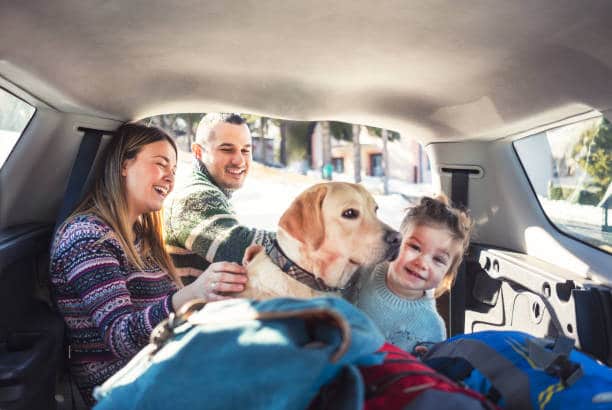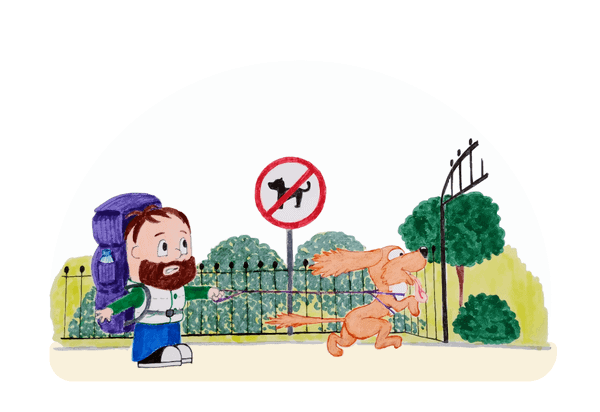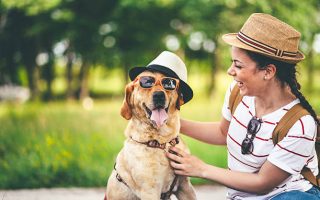Pets can become the center of your life, and living without them can be very hard indeed. Of course, you can always take them along wherever you go! And if you need to move or relocate, it’s hardly imaginable leaving your dog behind. But a car is not a dog’s natural habitat, and as such as much as a dog may seem to be enjoying the ride. Our 10 Car Travel Tips to Go Along Safely with your lab will help you.
It can also have a lot of difficulties adjusting to a moving vehicle. It may even turn out to be dangerous for either you or your canine or both. Luckily, there are a number of steps you can follow to ensure that the journey is safe and comfortable for both you and your beloved dog. After all. As much as you can’t bear being separated from it, you don’t want it to get hurt either, do you?

Regardless of where you are taking your dog and your mode of travel, an identification tag for your dog is absolutely essential. Not only will it help in marking your dog out in a crowd. Should it lost, but will also help in finding it again. Providing your name and phone number or other contact details. As well as the location of your destination in the tag is thus very important, along with your dog’s name. If you prefer that your dog doesn’t wear a collar, consider making an exception when you’re going out with it. The collar can also fit with a microchip so your dog can easily tracked via GPS should it ever get lost. Taking these measures will make a large difference towards ensuring that you’re always connected to your dog.
Travel With Lab: Get them used to travelling
Travelling as a new experience can be very uncomfortable and confining for a dog; the best way to make it as comfortable as possible is to used to travelling over a period of time. Taking it suddenly on a long drive one day can be very risky. Instead. You should it used to travelling in cars by taking it on short drives now. And then increasing its familiarity and comfort levels with car-travel in general and your car in particular. If you think you’re likely to move somewhere far in the future and take your dog along then it is essential. That you start it on its car travel training as early as possible following this method. This will reduce fidgeting and discomfort for both you and your dog.
Travel With Lab: Stop to feed and feed only at stops
Feeding your canine companion in a moving car is a very bad idea. It could lead to complications including nausea and in general a messy car. The best move is to feed it 3-4 hours before the start of the journey and then feed it only at stops. If it’s a long journey and your dog needs to eat then ensure that you find a good place where to stop and feed it. Do not feed it very rich food at one go either, especially before the start of the journey. Dogs often suffer car sickness very similar to humans and stuffing it with rich food will only enhance the problem; combined with the motion and the claustrophobic interiors of a car (especially for an active dog) it can make it feel very sick and nauseated.
Travel With Lab: Make sure your dog is secure
Dogs are just as prone to accidents and injuries due to sudden jerks as humans. It is thus essential that you ensure that your dog is safe and secure in the car. Most dogs may love freedom and activity. But it is generally not a good idea to let it roam around freely inside a car. Especially during a long journey: a car, after all, is not your home or a playground. Since most dogs will not take well to arrangements like seat-belts. Putting it in a crate or cage for the duration of the journey might be a good idea.
Should you choose to do so, however, you must ensure that the crate itself is secure and that the dog has enough space to move around, sit and lie down inside it. Make sure the crate is made of durable material, can fit into your car without making your dog uncomfortable. And your dog used to being inside it prior to the start of the journey.
Travel With Lab: Don’t leave your dog alone in the car
This is a singularly bad idea. Dogs love moving around and open space. Leaving it alone in the car without a familiar face to watch over it might get it very agitated and scared. Leading to heavy damage and injuries both to your car and (more importantly) your dog. Moreover, a car being an extremely stuffy and claustrophobic place with a metal outer covering. It can become very hot during summers and freezing cold during winter. This can lead to severe heatstroke and risks of freezing respectively. As is often reported as happening to many unfortunate dogs left in similar circumstances. A dog may even die of heatstroke or being frozen, in a particularly agonizing way. Regardless, such a situation is extremely uncomfortable and unhealthy for a dog and should be avoided.
Travel With Lab: No head outside window
The view of the outside flashing by as your vehicle moves along may not be very appealing to most humans used to car travel. But it is very entrancing and enticing to canines. The feel of the air hitting its face can be very appealing as well. Dogs can often seen with their heads hanging out of the windows of moving vehicles, tongues wagging in the wind. It is, however, a very bad idea to let your dog do so. For the same reason that it’s unsafe to let a human do so.
The dog may hit by any number of things, from flying objects to other reckless moving vehicles, leading to severe injuries or even death. Make sure your windows up, and if it is too hot to do so, that your dog is safely harnessed to a seat belt or inside a cage. Also never let your dog travel in the front seat unless it’s absolutely tiny.
Travel With Lab: Keep a pet/first aid kit handy
Keeping a first aid kit in your car is a good idea in general. But doubly so if you have your dog travelling with you. You never know what emergencies or injuries may arise, and it’s wise to prepared as much as possible. The first aid kit should ideally contain gauze, bandages, any medications your dog may require, and hydrogen peroxide in case you need to make your dog vomit. Moreover, keep other items specific to your dog in the kit as well. Like its bowl, leash, bags, supplies for grooming, and waste-disposal items. Also consider bringing your dog’s favorite toy or plushie to make it more at ease. Moving or travelling from one place to another can be a traumatizing and unnerving experience with a strong sense of displacement, so it’s always nice to have something familiar.
Buy/bring your own water
As we all know, the taste and mineral content of water varies widely between regions; moreover, water from unfamiliar regions may not be safe. It is thus generally a good idea to buy packaged and certified drinking water or, better yet, to bring along your own water if possible. Your dog’s familiarity to the water will make it easier for it to drink it thus also eliminating any possible complications. Also consider bringing extra water (and food) if you’re unsure how long the journey will take. And on that note, ensure that your dog does not drink or eat anything unfamiliar at stops during your journey.
Make the insides of your car as comfortable as possible
We’ve gone over just how uncomfortable a car can be, both for your dog and you; there are, of course, ways to reduce the discomfort to an extent. There’s a number of ways your car can outfitted to make it more comfortable. From floor liners to seat covers. If your car floors rubberized, it is both more comfortable for your dog’s feet as well as safer, should your dog somehow find itself on the floor there is lesser chance of injury.
Waterproof seat covers will reduce damage to your car and ensuing discomfort to any canine or human passengers should your dog happen to soil or otherwise spill food or liquid on the seats. Preparations to make you’re the drive as smooth as possible for your dog can started long before the journey itself, and if you know you’re going to travel with it it’s best to invest in these.
Always be watchful
Even with all these precautions, you yourself as the dog’s owner and its travel guide should always be extra careful and watchful over your precious pet. There’s any number of mishaps your dog into despite the best pre-planned countermeasures; any number of smells, sounds or sights during a drive may agitate and scare them, leading them to seek shelter and become hyperactive. Small dogs may even seek shelter under the seats, even under the driver’s legs. Open windows are not only hazardous for dogs with a tendency to poke their head out. At rest stops, they may find something highly enticing and run off into the unknown if you aren’t keeping watch. Remember, nothing substitutes for a caring and watchful owner!




